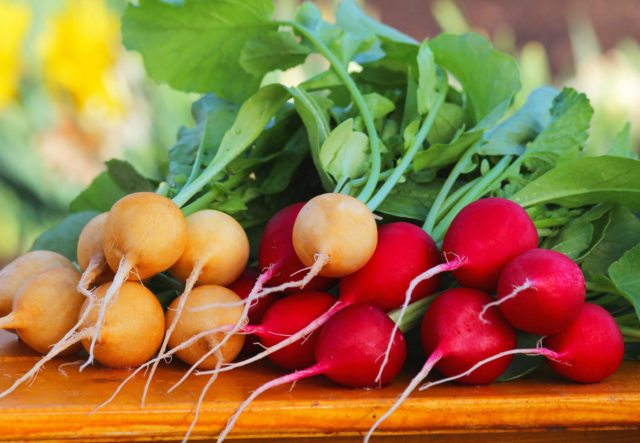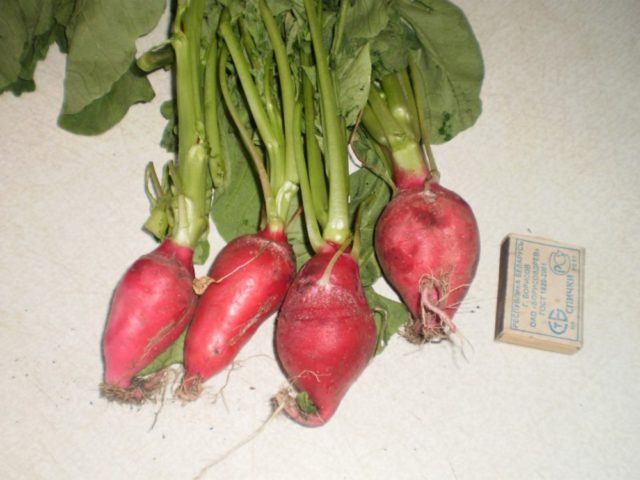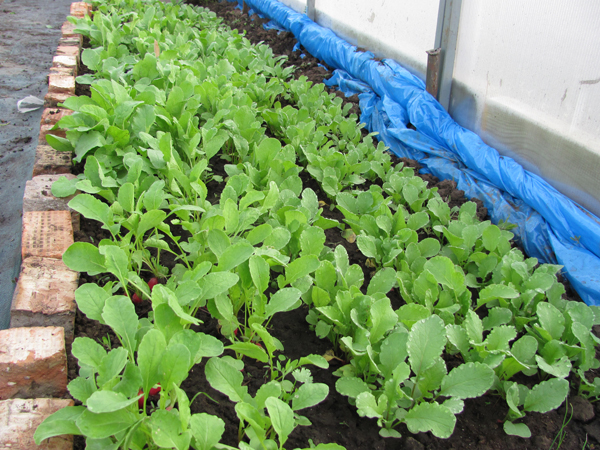Content
Often, when planting a crop such as radish, gardeners are faced with a problem when, instead of forming a juicy crunchy root crop, the plant throws out a long shoot - an arrow. In this case, there is no need to wait for the harvest, the hard, elongated root of such a radish is not suitable for eating. There may be several reasons why the radish goes to the arrow instead of laying a full-fledged root crop.
What radishes don't like
Radish is a wonderful vegetable; it is one of the first to appear on the tables of gardeners in the new season. Many consider it to be extremely unpretentious and treat it according to the principle of "plant and all right", hoping that the plant will yield a crop without any care. However, it is not. Although the plant is undemanding to care, it is not worth waiting for a good harvest, relying only on the fertility of the land and good weather.
Radish doesn't like extremes. For him, both too cold and too hot weather are undesirable. Therefore, it is not grown in summer. You can plant radishes quite early. Sowing seeds is recommended when the ground warms up to + 3-5 ° С, however, for normal growth, a temperature of at least + 8-10 ° С is needed, and for the formation of a root crop - at least + 18 ° С. Deviations from these conditions negatively affect the growth and yield of radish.
In addition to the ambient temperature, radishes are sensitive to soil moisture. Moreover, both an excess of moisture and a lack of it can negatively affect the crops. Harvest quality is negatively affected and too dense planting.
Why is radish shooting and what to do
The reasons for radish shooting can be very different. Most often this happens due to the following violations of the rules of agricultural technology:
- Planting material of poor quality or inappropriate to the climatic conditions of the region.
- Landing Violations.
- Improper care.
- Disease or the appearance of pests on plantings.
Poor quality planting material
The likelihood that the radish will go into the arrow directly depends on the quality of the planting material. For planting, it is advisable to select only the largest seeds. You can not use planting material with an expired shelf life.
Wrong variety selected
When choosing seeds, you should pay attention to which region the radish variety is zoned for. Often this discrepancy leads to the fact that the bush releases an arrow. The plant simply cannot adapt to the conditions of another, unsuitable climate, and in this case the biological defense mechanism is triggered. Radish begins not to lay a root crop, but to spend all its energy on shooting, flowering and further growing and ripening of seeds.
Violation of landing rules
Violation of planting rules is one of the most likely reasons for which radishes go to the arrow. Most often this is due to non-compliance with the timing of planting seeds. If you sow radishes too late, for example, in late May or early June, then too long daylight hours will inevitably lead to the fact that the radish will throw out the arrow and begin to bloom.This culture loves open sunny areas, but an excess of sunlight affects it in the same way as a lack of it. When planted in the shade, radishes will grow poorly and are more likely to shoot an arrow.
The composition of the soil on which this culture grows is also important. The soil should be loose, breathable and well moisturized. Hard clay soil provokes shooting.
Density of plantings
Often, radishes go into the arrow when they are too densely planted. This plant is usually sown in rows, however, after the emergence of shoots, it is imperative to calibrate and thin out the plantings, removing the weakest plants and ensuring a normal spacing between adjacent bushes. Too frequent planting will inevitably lead to competition between neighboring plants, and this, in turn, can trigger the biological defense mechanism already mentioned above, provoking shooting.
Irregularities in watering schedule
Radish is a moisture-loving plant, it responds very well to watering. With a lack of moisture, the likelihood of shooting increases significantly, and the quality of the root crops themselves deteriorates. The lack of water leads to the fact that the internal structure of the root vegetable becomes like cotton wool, and the taste appears harshness and bitterness. Therefore, the beds must be moderately but regularly moistened. The normal frequency of watering radishes is 3-4 times a week. If the weather is dry, you need to water the plants daily, in the evening hours. It is necessary to strive to ensure that the soil is moistened by 15-20 cm, at such a depth are all the roots of the plant that help form the root crop.
Excess or lack of nutrients
A lack of nutrients in the soil or an excess of them can lead to shooters of radishes. In particular, an excess of nitrogen fertilizers can provoke an uncontrolled growth of green mass, while the underground part of the plant will remain undeveloped. For this reason, fresh manure is not applied under the radish, which greatly enriches the soil with nitrogen. This plant has a very short growing season, so all fertilizers must be either dissolved in water or applied in advance, optimally in the fall, along with digging the site. Foliar dressing with the help of complex potassium-phosphorus fertilizers is also allowed.
Pests and diseases
Pests and diseases appear infrequently on radishes. This is due to the short ripening period of this culture, by the time of harvest, many insects still do not even appear on the surface of the earth after hibernation. However, diseases and pests can indirectly cause radish shooting. When the first signs of infection appear, diseased plants must be removed, and the plantings and soil must be treated with fungicide solutions.
Why does radish go to the tops
Strong growth of radish tops instead of full-fledged root crops usually indicates an excess of nitrogen in the soil. For this reason, nitrogen-containing fertilizers should be applied with great care in the spring. When grown in a greenhouse, the cause of excessive growth of greenery or going into the arrow can be increased temperature and humidity. In such conditions, the plants begin to "fatten", increasing the aboveground part to the detriment of the underground. A temperature of + 20-22 ° C is considered normal for growing radishes.
An additional factor that has a direct impact on the growth of green mass and increases the likelihood of entering the arrow will be too long daylight hours. To avoid negative consequences, the period of illumination is artificially limited to 12 hours per day. This is quite enough for the plants to feel normal.You can shade radishes with black plastic wrap.
What to do to prevent radishes from going to the arrow or to the tops
Summarizing the above, we can say that in order to obtain a good harvest of radish and the absence of shooting at the same time, it is necessary to carry out a number of mandatory measures in advance. The complete algorithm may look like this.
- Seed selection and calibration. It is necessary to purchase planting material in advance that is suitable for growing in the specific conditions of a given region and suitable in terms of ripening. Be sure to pay attention to the shelf life of seeds, for radishes it is no more than 5 years. Seeds need to be rejected and calibrated, removing small ones affected by pests or diseases, as well as having mechanical damage.
- Preparing the landing site. You need to choose a well-lit place where suitable predecessors grew before the radish, with loose fertile soil. It is advisable to dig the site in the fall.
- Planting and leaving. Landing within the established timeframe. Before seedlings emerge, the beds can be covered with plastic wrap to prevent hypothermia. After the emergence of seedlings, it is necessary to thin and calibrate the plants, removing weak shoots and ensuring a normal spacing between adjacent shoots. During cultivation, it is necessary to regularly water the radish in moderation, loosen the soil. Top dressing should be applied in moderation, especially nitrogen-containing ones.
- When grown in a greenhouse, it is necessary to artificially limit the length of daylight hours, and it is also advisable to prevent the temperature from rising above + 22 ° C.
It should be noted that some varieties of radish have a predisposition to go into the arrow. Therefore, before buying seeds, you should pay attention to this quality. If the gardener cannot fully comply with all the recommendations for caring for crops, then it is better to give preference to varieties that do not have such a propensity. Varieties that grow into an arrow relatively rarely include, for example, Heat, Early Red, Ruby, Ice Icicle.
Conclusion
Radish goes to the arrow most often due to a combination of factors, and not for one particular reason. Therefore, it is necessary to analyze all possible options, check the conditions in which the planting was carried out, determine the sufficiency of measures for plant care, choose and experiment with seed material. This will help determine the optimal conditions and choose the right type of radish for yourself so that there are isolated cases of growing into an arrow.











